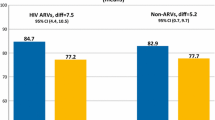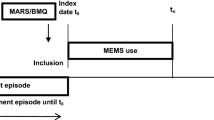Abstract
Nonadherence to antidepressants is widespread and poses a significant barrier to optimal management and treatment of depression in community settings. The objective of this study was to compare self-reported and electronic monitoring of adherence to antidepressants and to examine the relationship of these measures with depressive symptoms in a medically underserved community. Adherence to antidepressants was measured in 38 primary care patients from the West Philadelphia area using self-report and electronic monitoring (Medication Event Monitoring System caps). Self-report and electronic monitoring of antidepressant adherence showed fair agreement at baseline, slight agreement at 6 weeks, and slight agreement at 12 weeks. Adherence to antidepressants as assessed by electronic monitors was significantly associated with depression remission at 12 weeks [adjusted odds ratio 18.6, 95% confidence interval (1.05, 330.56)]. Compared with electronic monitoring, self-reported adherence tended to overestimate medication adherence to antidepressants. Adherence assessed by electronic monitoring was associated with depression remission.
Similar content being viewed by others
References
Abada, S., Clark, L. E., Sinha, A. K., Xia, R., Pace-Murphy, K., Flores, R. J., et al. (2019). Medication regimen complexity and low adherence in older community-dwelling adults with substantiated self-neglect. Journal of Applied Gerontology,38(6), 866–883.
Alegria, M., NeMoyer, A., Falgas Bague, I., Wang, Y., & Alvarez, K. (2018). Social determinants of mental health: Where we are and where we need to go. Current Psychiatry Reports,20(11), 95. https://doi.org/10.1007/s11920-018-0969-9.
Angst, J. (1988). Clinical course of affective disorders. Depressive Illness. https://doi.org/10.1007/978-3-642-73546-2_1.
Barbui, C., Cipriani, A., Patel, V., Ayuso-Mateos, J. L., & van Ommeren, M. (2011). Efficacy of antidepressants and benzodiazepines in minor depression: Systematic review and meta-analysis. The British Journal of Psychiatry,198(1), 11–16. https://doi.org/10.1192/bjp.bp.109.076448.
Bauer, A., Parker, M., Schillinger, D., Katon, W., Adler, N., Adams, A., et al. (2014). Associations between antidepressant adherence and shared decision-making, patient-provider trust, and communication among adults with diabetes: Diabetes Study of Northern California (DISTANCE). Journal of General Internal Medicine,29(8), 1139–1147.
Bosman, J., Ter Horst, P. G., Smit, J. P., Dijkstra, J. R., Beekhuis, H. R., Slingersland, R. J., et al. (2014). Adherence of antidepressants during pregnancy: MEMS compared with three other methods. Therapeutic Advances in Psychopharmacology,4(2), 61–69. https://doi.org/10.1177/2045125313511486.
Brown, M. T., & Bussell, J. K. (2011). Medication adherence: WHO cares? Mayo Clinic Proceedings,86(4), 304–314. https://doi.org/10.4065/mcp.2010.0575.
Campbell, J. P., Maxey, V. A., & Watson, W. A. (1995). Hawthorne effect: Implications for prehospital research. Annals of Emergency Medicine,26(5), 590–594.
Choudhry, N. K., Shrank, W. H., Levin, R. L., Lee, J. L., Jan, S. A., Brookhart, M. A., et al. (2009). Measuring concurrent adherence to multiple related medications. The American Journal of Managed Care,15(7), 457–464.
Cipriani, A., Furukawa, T. A., Salanti, G., Chaimani, A., Atkinson, L. Z., Ogawa, Y., … Geddes, J. R. (2018). Comparative efficacy and acceptability of 21 antidepressant drugs for the acute treatment of adults with major depressive disorder: A systematic review and network meta-analysis. Lancet, 391(10128), 1357–1366. doi:10.1016/s0140-6736(17)32802-7.
Claxton, A. J., Cramer, J. B., & Pierce, C. (2001). A systematic review of the associations between dose regimens and medication compliance. Clinical Therapeutics,23(8), 1296–1310.
Croghan, T. W., Lair, T. J., Engelhart, L., Crown, W. E., Copley-Merriman, C., Melfi, C. A., et al. (1997). Effect of antidepressant therapy on health care utilization and costs in primary care. Psychiatric Services (Washington, D. C.),48(11), 1420–1426. https://doi.org/10.1176/ps.48.11.1420.
Crum, R. M., Anthony, J. C., Bassett, S. S., & Folstein, M. F. (1993). Population-based norms for the Mini-Mental State Examination by age and educational level. JAMA,269(18), 2386–2391.
de Vries McClintock, H. F., Boyle, K. B., Rooney, K., & Bogner, H. R. (2016). Diabetes and depression care: A randomized controlled pilot trial. American Journal of Health Behavior,40(4), 503–513. https://doi.org/10.5993/ajhb.40.4.12.
Farmer, K. C. (1999). Methods for measuring and monitoring medication regimen adherence in clinical trials and clinical practice. Clinical Therapeutics,21(6), 1074–1090. https://doi.org/10.1016/s0149-2918(99)80026-5. (discussion 1073).
Garber, M. C., Nau, D. P., Erickson, S. R., Aikens, J. E., & Lawrence, J. B. (2004). The concordance of self-report with other measures of medication adherence: A summary of the literature. Medical Care,42(7), 649–652.
Garfield, S., Clifford, S., Eliasson, L., Barber, N., & Willson, A. (2011). Suitability of measures of self-reported medication adherence for routine clinical use: A systematic review. BMC Medical Research Methodology,11, 149. https://doi.org/10.1186/1471-2288-11-149.
George, C. F., Peveler, R. C., Heiliger, S., & Thompson, C. (2000). Compliance with tricyclic antidepressants: The value of four different methods of assessment. British Journal of Clinical Pharmacology,50(2), 166–171.
Hashmi, S. K., Afridi, M. B., Abbas, K., Sajwani, R. A., Saleheen, D., Frossard, P. M., …, Ahmad, U. (2007). Factors associated with adherence to anti-hypertensive treatment in Pakistan. PLoS ONE, 2(3), e280. doi:10.1371/journal.pone.0000280.
Heckman, B. D., Catz, S. L., Heckman, T. G., Miller, J. G., & Kalichman, S. C. (2004). Adherence to antiretroviral therapy in rural persons living with HIV disease in the United States. AIDS Care,16(2), 219–230. https://doi.org/10.1080/09540120410001641066.
Interian, A. (2010). A brief self-report measure to assess antidepressant adherence among Spanish-speaking Latinos. Journal of Clinical Psychopharmacology,30(6), 755–757. https://doi.org/10.1097/JCP.0b013e3181fb57f8.
Iribarren, S. J., Cato, K., Falzon, L., & Stone, P. W. (2017). What is the economic evidence for mHealth? A systematic review of economic evaluations of mHealth solutions. PLoS ONE,12(2), e0170581.
Kahn, R. S., Wise, P. H., Kennedy, B. P., & Kawachi, I. (2000). State income inequality, household income, and maternal mental and physical health: Cross sectional national survey. BMJ,321(7272), 1311–1315. https://doi.org/10.1136/bmj.321.7272.1311.
Kleinberg, A., Aluoja, A., & Vasar, V. (2013). Social support in depression: Structural and functional factors, perceived control and help-seeking. Epidemiology and Psychiatric Sciences,22(4), 345–353. https://doi.org/10.1017/s2045796013000504.
Kroenke, K., Spitzer, R. L., & Williams, J. B. (2001). The PHQ-9: Validity of a brief depression severity measure. Journal of General Internal Medicine,16(9), 606–613.
Lee, M. S., Lee, H. Y., Kang, S. G., Yang, J., Ahn, H., Rhee, M., …, Kim, S. H. (2010). Variables influencing antidepressant medication adherence for treating outpatients with depressive disorders. Journal of Affective Disorders, 123(1–3), 216–221. doi:10.1016/j.jad.2009.10.002.
Marlowe, D., & Crowne, D. P. (1961). Social desirability and response to perceived situational demands. Journal of Consulting Psychology,25, 109–115.
McHorney, C. A. (1996). Measuring and monitoring general health status in elderly persons: Practical and methodological issues in using the SF-36 Health Survey. Gerontologist,36(5), 571–583.
Melfi, C. A., Chawla, A. J., Croghan, T. W., Hanna, M. P., Kennedy, S., & Sredl, K. (1998). The effects of adherence to antidepressant treatment guidelines on relapse and recurrence of depression. Archives of General Psychiatry,55(12), 1128–1132.
Nakonezny, P. A., Hughes, C. W., Mayes, T. L., Sternweis-Yang, K. H., Kennard, B. D., Byerly, M. J., et al. (2010). A comparison of various methods of measuring antidepressant medication adherence among children and adolescents with major depressive disorder in a 12-week open trial of fluoxetine. Journal of Child and Adolescent Psychopharmacology,20(5), 431–439. https://doi.org/10.1089/cap.2009.0108.
National Academies of Sciences, Engineering, and Medicine. (2016). A framework for educating health professionals to address the social determinants of health. Washington, DC: The National Academies Press.
Neath, I. (1993). Distinctiveness and serial position effects in recognition. Memory & Cognition,21(5), 689–698.
Nguyen, T. M., La Caze, A., & Cottrell, N. (2014). What are validated self-report adherence scales really measuring?: A systematic review. British Journal of Clinical Pharmacology,77(3), 427–445. https://doi.org/10.1111/bcp.12194.
Odegard, P. S., & Gray, S. L. (2008). Barriers to medication adherence in poorly controlled diabetes mellitus. The Diabetes Educator,34(4), 692–697. https://doi.org/10.1177/0145721708320558.
Olfson, M., Marcus, S. C., Tedeschi, M., & Wan, G. J. (2006). Continuity of antidepressant treatment for adults with depression in the United States. American Journal of Psychiatry,163(1), 101–108. https://doi.org/10.1176/appi.ajp.163.1.101.
Osterberg, L. B. T. (2005). Adherence to medication. The New England Journal of Medicine,353(5), 487–497. https://doi.org/10.1056/NEJMra050100.
Rapaport, M. H., & Judd, L. L. (1998). Minor depressive disorder and subsyndromal depressive symptoms: Functional impairment and response to treatment. Journal of Affective Disorders,48(2–3), 227–232.
Rickles, N. M., & Svarstad, B. L. (2007). Relationships between multiple self-reported nonadherence measures and pharmacy records. Research in Social and Administrative Pharmacy,3(4), 363–377. https://doi.org/10.1016/j.sapharm.2006.11.001.
Salazar-Fraile, J., Sempere-Verdu, E., Perez-Hoyos, S., Tabares-Seisdedos, R., & Gomez-Beneyto, M. (2018). Five interpersonal factors are predictive of the response to treatment of major depression with antidepressants in primary care. Frontiers in Psychiatry,9, 416. https://doi.org/10.3389/fpsyt.2018.00416.
Sansone, R. A., & Sansone, L. A. (2012). Antidepressant adherence: Are patients taking their medications? Innovations in Clinical Neuroscience,9(5–6), 41–46.
Shi, L., Liu, J., Koleva, Y., Fonseca, V., Kalsekar, A., & Pawaskar, M. (2010). Concordance of adherence measurement using self-reported adherence questionnaires and medication monitoring devices. Pharmacoeconomics,28(12), 1097–1107. https://doi.org/10.2165/11537400-000000000-00000.
Stadnyk, K., Calder, J., & Rockwood, K. (1998). Testing the measurement properties of the Short Form-36 Health Survey in a frail elderly population. Journal of Clinical Epidemiology,51(10), 827–835.
Stewart, A. L. (1992). Measuring functioning and well-being: The medical outcomes study. Durham, NC: Duke University Press.
Stewart, A. L., Greenfield, S., Hays, R. D., Wells, K., Rogers, W. H., Berry, S. D., …,Ware, J. E., Jr. (1989). Functional status and well-being of patients with chronic conditions. Results from the Medical Outcomes Study. JAMA, 262(7), 907–913.
Stewart, A. L., Hays, R. D., & Ware, J. E., Jr. (1988). The MOS short-form general health survey. Reliability and validity in a patient population. Medical Care,26(7), 724–735.
Stewart, J. W., McGrath, P. J., & Quitkin, F. M. (1992). Can mildly depressed outpatients with atypical depression benefit from antidepressants? American Journal of Psychiatry,149(5), 615–619. https://doi.org/10.1176/ajp.149.5.615.
Stone, A. A., Bachrach, C. A., Jobe, J. B., Kurtzman, H. S., & Cain, V. S. (2000). The scient of self-report: Implications for research and practice (1st ed.). Mahwah, NJ: Lawrence Erlbaum Associates Inc.
Tedlow, J. R., Maurizio, F., Uebelacker, L. A., Alpert, J. E., Nierenberg, A. A., & Rosenbaum, J. F. (1996). Are study dropouts different from completers? Biological Psychiatry,40(7), 668–670. https://doi.org/10.1016/0006-3223(96)00204-1.
Thompson, C., Peveler, R. C., Stephenson, D., & McKendrick, J. (2000). Compliance with antidepressant medication in the treatment of major depressive disorder in primary care: A randomized comparison of fluoxetine and a tricyclic antidepressant. American Journal of Psychiatry,157(3), 338–343. https://doi.org/10.1176/appi.ajp.157.3.338.
Voils, C. I., Steffens, D. C., Flint, E. P., & Bosworth, H. B. (2005). Social support and locus of control as predictors of adherence to antidepressant medication in an elderly population. The American Journal of Geriatric Psychiatry,13(2), 157–165. https://doi.org/10.1176/appi.ajgp.13.2.157.
Wells, K. B., Stewart, A., Hays, R. D., Burnam, M. A., Rogers, W., Daniels, M., …, Ware, J. (1989). The functioning and well-being of depressed patients. Results from the Medical Outcomes Study. JAMA, 262(7), 914–919.
World Health Oraganization. (2019). Social determinants of health. Retrieved May 15, 2019, from https://www.who.int/social_determinants/sdh_definition/en/.
Yoshikawa, H., Aber, J. L., & Beardslee, W. R. (2012). The effects of poverty on the mental, emotional, and behavioral health of children and youth: Implications for prevention. American Psychologist,67(4), 272–284. https://doi.org/10.1037/a0028015.
Author information
Authors and Affiliations
Corresponding author
Ethics declarations
Conflict of interest
The authors have no financial or any other kind of conflict of interest to declare.
Additional information
Publisher's Note
Springer Nature remains neutral with regard to jurisdictional claims in published maps and institutional affiliations.
Rights and permissions
About this article
Cite this article
McClintock, H.F., BeKampis, A.N., Hartmann, E. et al. Adherence to Antidepressants in Underserved Communities: A Comparison of Electronic Monitoring and Self-report Measures. Community Ment Health J 56, 727–734 (2020). https://doi.org/10.1007/s10597-019-00533-2
Received:
Accepted:
Published:
Issue Date:
DOI: https://doi.org/10.1007/s10597-019-00533-2




